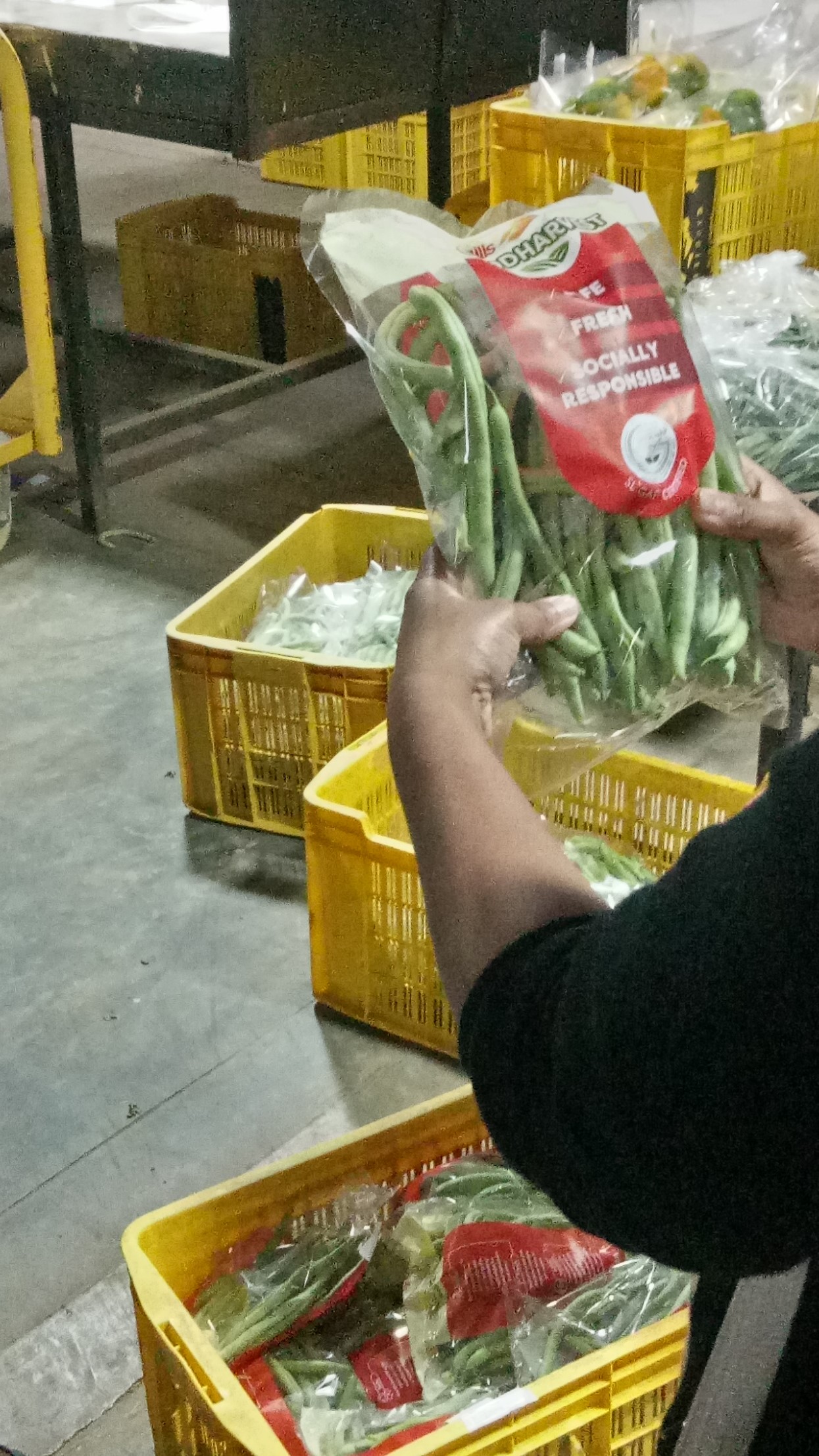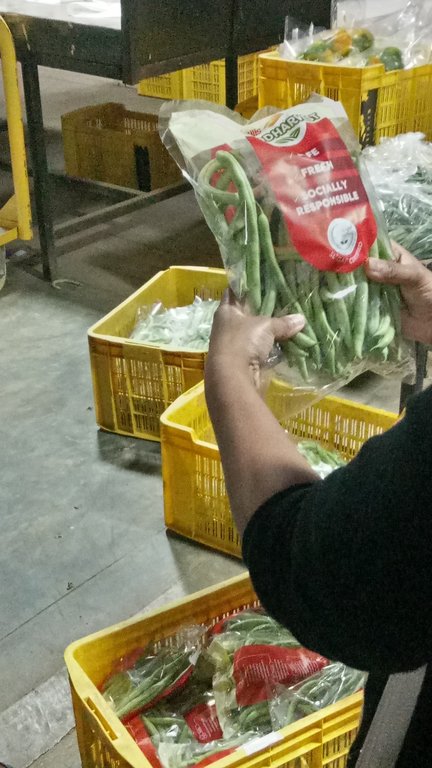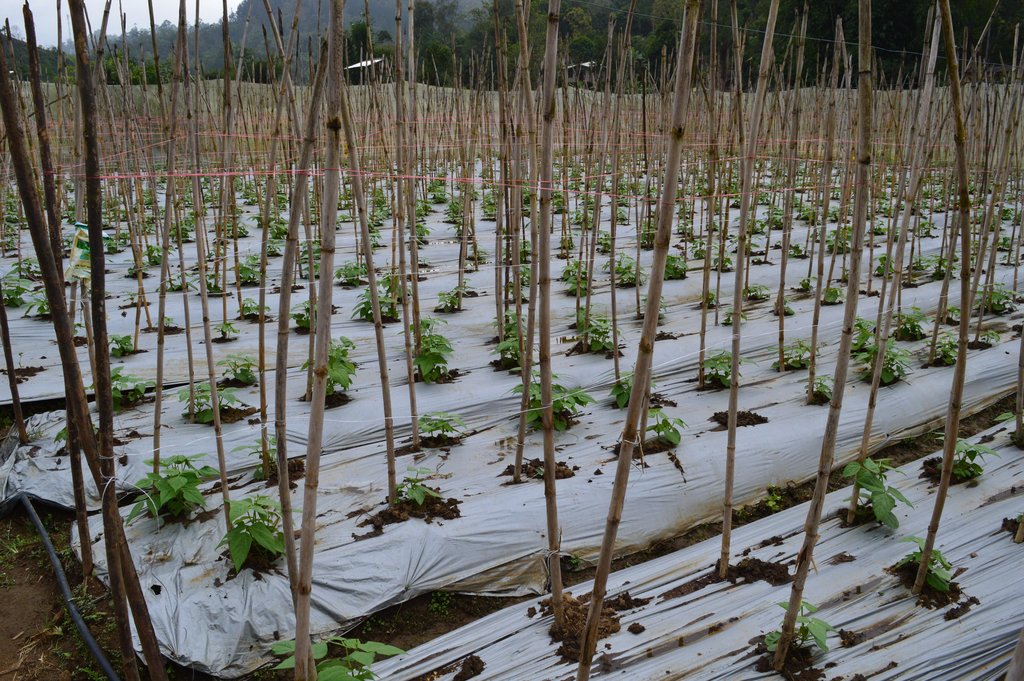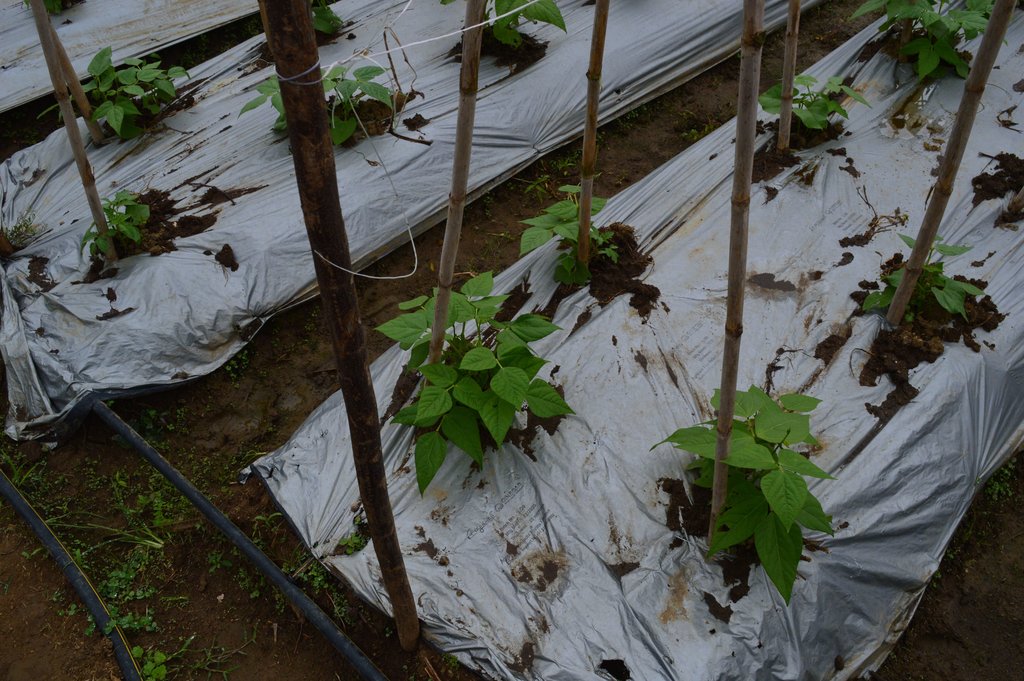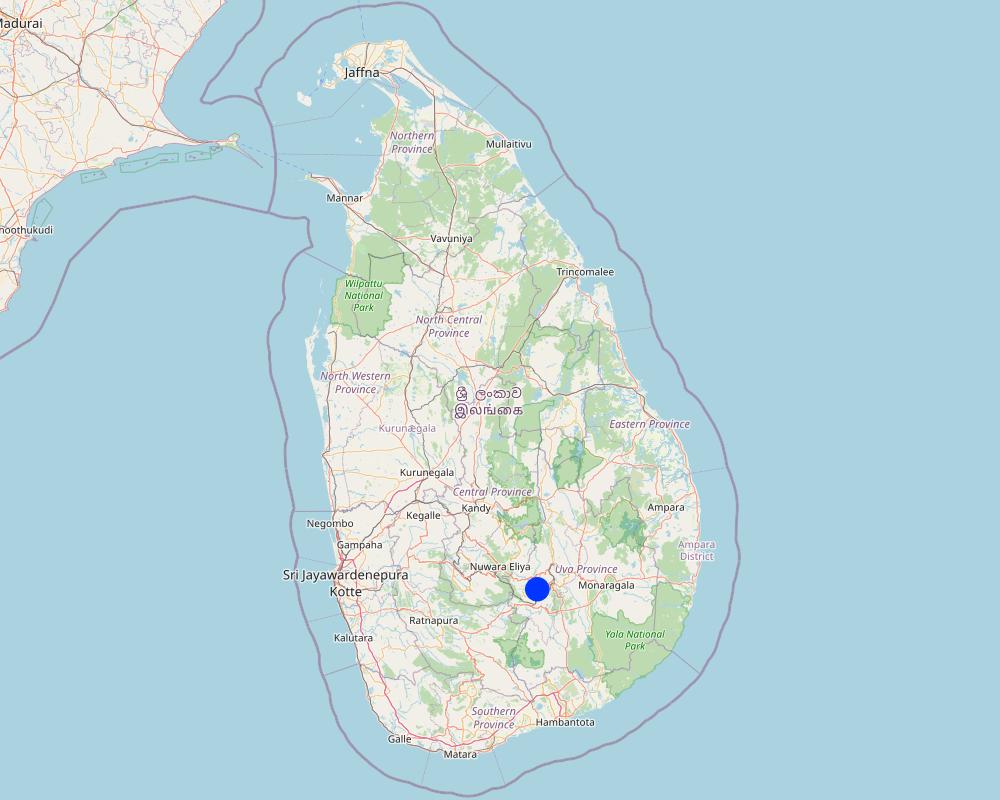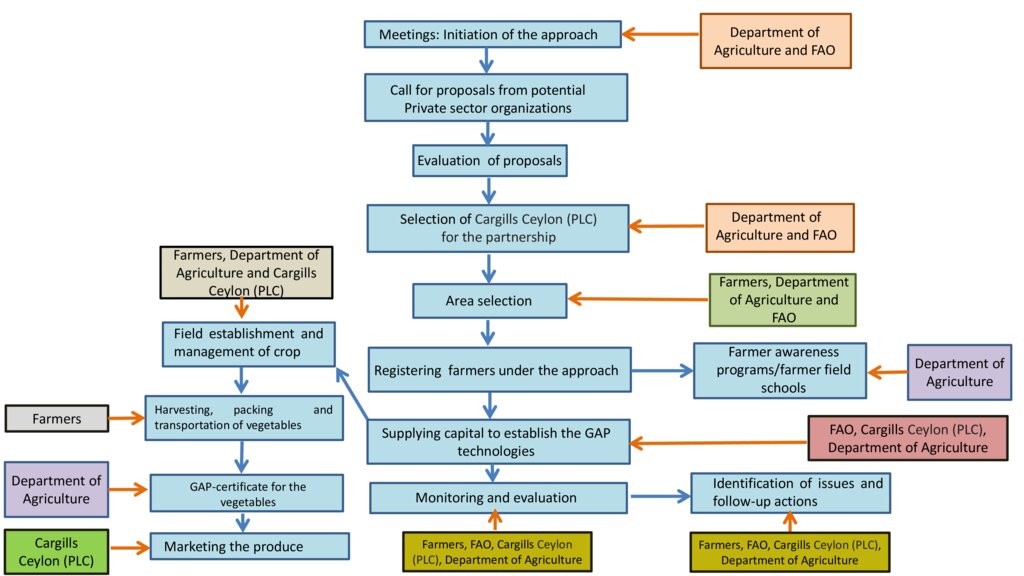Private-public partnership to promote Sustainable Land Management and Good Agricultural Practices among vegetable growers [Шри-Ланка]
- Создание:
- Обновить:
- Составитель: Head Soil Science
- Редактор: –
- Рецензенты: William Critchley, Joana Eichenberger
GAP Program
approaches_6229 - Шри-Ланка
Просмотреть разделы
Развернуть все Свернуть все1. Общая информация
1.2 Контактные данные специалистов и организаций, участвующих в описании и оценке Подхода
Ответственный (-ые) специалист (-ы)
землепользователь:
Leelarathna Herath Mudiyanselage
+94 713586312
Ketakela, Ambegoda, Bandarawela
Шри-Ланка
Специалист по УЗП:
Karunathilaka D.L. Manoj
+9477 3992261
manoj.ka@cargillsceylon.com
Cargills (Ceylon) PLC
40, York Street, Colombo
Шри-Ланка
Специалист по УЗП:
Jayaweera Tharindu
+94713586312
tmjanusha@gmail.com
Department of Agriculture, Sri Lanka
Agrarian Service Centre, Bandarawela
Шри-Ланка
Специалист по УЗП:
Gunasena Nimal
+94714490338
Nimal.Gunasena@fao.org
Food and Agriculture Organization of United Nations
202, Bauddhaloka Mawatha, Colombo 00700
Шри-Ланка
землепользователь:
Bandara K.M.S.J Jayasiri
+94741066961
No. 178, Ketakela, Ambegoda, Bandarawela
Шри-Ланка
co-compiler:
Attanayake Chammi
(+)94 71 147 2288
chammiatt@agri.pdn.ac.lk / chammiattanayake@gmail.com
Department of Soil Science, Faculty of Agriculture, University of Peradeniya
Peradeniya, Sri Lanka
Шри-Ланка
co-compiler:
Название проекта, содействовавшего документированию/оценке Подхода (если применимо)
Rehabilitation of Degraded Agricultural Lands in Kandy, Badulla and Nuwara Eliya Districts in the Central Highlands of Sri LankaНазвание организации (-ий), содействовавших документированию/оценке Подхода (если применимо)
Food and Agriculture Organization of the United Nations (FAO) - ИталияНазвание организации (-ий), содействовавших документированию/оценке Подхода (если применимо)
Faculty of Agriculture, University of Peradeniya, Sri Lanka (AGRI.PDN) - Шри-ЛанкаНазвание организации (-ий), содействовавших документированию/оценке Подхода (если применимо)
Department of Agriculture, Sri Lanka (DOA) - Шри-ЛанкаНазвание организации (-ий), содействовавших документированию/оценке Подхода (если применимо)
Cargills (Ceylon) PLC (Cargills) - Шри-Ланка1.3 Условия, регламентирующие использование собранных ВОКАТ данных
Когда были собраны данные (на местах)?
24/02/2022
Составитель и ответственный/-ые специалист(-ы) согласны с условиями, регламентирующими использование собранных ВОКАТ данных:
Да
1.4 Ссылка (-и) на Анкету (-ы) по Технологиям УЗП
2. Описание Подхода УЗП
2.1 Краткое описание Подхода
A private-public partnership overcomes constraints that vegetable farmers encounter when adopting novel SLM technologies and Good Agricultural Practices. The private sector helps with marketing, value addition, certification, and financial support. The public sector fulfils farmer training needs through (for example) Farmer Field Schools using digital platforms.
2.2 Подробное описание Подхода
Подробное описание Подхода:
This approach was implemented in vegetable growing lands in hilly and rolling terrain, where the average annual rainfall is relatively high: Wet zone (>2500 mm) Intermediate zone (1750-2500 mm-short dry periods). Controlling soil erosion is crucial in these regions. Further, overuse and misuse of agrochemicals are common among the farmers. On the other hand, farmers experience lack of market opportunities, lack of technical and financial support and water scarcity in the intermediate zone which restricts farming to 1 or 2 cropping cycles. This approach aims to support vegetable growers by providing financial and technical support to implement technologies to minimize soil erosion and increase fertilizer and water use efficiencies, while providing adequate market opportunities and product value addition.
In the field, the following technologies were implemented as a package: plastic mulch, terracing, drip irrigation systems, fertigation units and insect proof nets. Furthermore, capacity development programs were implemented along with continuous monitoring, financial support was provided to adopt the technologies. The market opportunity was expanded via value addition through “GAP-certification" (GAP = Good Agricultural Practices) and facilitating easy and secured access to market via private sector involvement.
By adopting this technological package farmers were able to reduce the fertilizer use by about 70-80 % via "fertigation" - that is fertilizer mixed in irrigation water. Further, the pest attacks and need of insecticides were significantly reduced due to insect proof nets. The weed growth was negligible due to the plastic mulch which reduced the labour cost significantly as previously, farmers used to control weeds manually. Soil erosion was minimal due to plastic mulch used over the contour terraces. The water use efficiency was improved via drip irrigation and the farming was not affected by the short drought periods. The overall cost reduction that the farmers experience by adopting this technological package was about 20%. Further, the yield increase was about 20%, which raised the profit by 30%. Proper use of pesticides with adequate safety measures and safe disposal of the pesticide containers are mandatory to be qualified for GAP-certification. Farmers that adopt this approach collect pesticide containers in a designated place in the farm.
The implementation of the approach was as follows:
1.Discussions between Food and Agriculture Organization of United Nations (FAO) and Department of Agriculture, Sri Lanka (DOA) to develop a private-public partnership (PPP).
2.Call for proposals from private sector supermarket owners and exporters.
3.The proposal of Cargills (Ceylon) PLC was accepted.
4.Areas with easy access to Cargill’s vegetable collection centers were selected for the pilot programme, namely Haguranketha and Nuwarleiya, Boralanda and Bandarawela.
5.Eighty progressive farmers who had been providing vegetables for the already established vegetable collection centers were selected for the initial program.
6.Farmer awareness programs and Farmer Field Schools were conducted on the technological package, the GAP certification process and market arrangements.
7.The technical package was installed in farmers’ fields. Farmers were supported financially to obtain raw materials and cover the capital cost (for polythene, drip irrigation systems, insect-proof nets and accessories, fertilizers and pesticides). The cost estimated to implement the package was Rs. 300,000 for quarter of an acre (Rs. 2.96 million/ha = approx. UD$ 8950/ha). Cargills and the FAO funded RDAL (Rehabilitation of degraded agricultural lands in the central highlands of Sri Lanka) shared 2/3 of the material cost. The rest of the cost was borne by the farmer. Cargills Bank provided low interest loans to farmers to cover their share of the capital cost.
8.Continuous monitoring and capacity development and motivational programs were implemented via field visits and WhatsApp groups.
9.GAP-certification was provided for the vegetables.
10.A market was provided by Cargills with a guaranteed 10% premium above the standard rate.
11.Alongside the implementation processes, other developments took place. These included: supply of fertilizers and pesticides to farmers and provision of study scholarships for children of the farmers by Cargills.
The limitations of the approach are as follows: first, reluctance of the farmers to follow the rigorous record-keeping process necessary to obtain the GAP-certification; second, the absence of a proper methodology to recycle or upcycle the pesticide containers; third, the on-going lack of consumer awareness about the GAP-certified products.
2.3 Фотографии, иллюстрирующие Подход
2.5 Страна/ регион/ место, где применялся Подход
Страна:
Шри-Ланка
Административная единица (Район/Область):
Bandarawela/Badulla District/Uva Province
Более точная привязка места:
Ambegoda Village
Комментарии:
Ambegoda village is located about 8 km away from Bandarawela town. Other than the studied site, this approach was implemented in Jaffna, Kilinochchi, Monaragala, Thabuttegama, Galenbindunuwewa, Boralanda, Adhikaarigama and Thanamalwila areas
Map
×2.6 Даты начала и окончания реализации Подхода
Год начала реализации:
2019
2.7 Тип Подхода
- в рамках проекта/ программы
2.8 Каковы цели/ задачи Подхода
This approach aims to support vegetable growers by providing financial and technical support to implement technologies to minimize soil erosion and increase fertilizer and water use efficiencies, while providing adequate market opportunities and product value addition via GAP-certification.
2.9 Условия содействующие применению Технологии/ Технологий в рамках Подхода или затрудняющие его
Наличие/ доступность финансовых ресурсов и услуг
- содействуют
Farmers are encouraged to get financial support from the Cargills (Ceylon) PLC to implement their technological package
Нормативно-правовая база (землевладение, права на земле- и водопользование)
- содействуют
The collaboration between government and private sector helped to build the trust among farmers about the approach
Осведомленность в области УЗП, доступность технической поддержки
- содействуют
The knowledge gained on SLM practices obtained through farmer field schools was important for the success of the approach
Рынки (для приобретения материалов и услуг, продажи продукции) и цены
- содействуют
The GAP certified agricultural produce was purchased by Cargills (Ceylon) PLC for a higher price; hence many farmers were motivated to implement the technology in their fields
3. Участие и распределение ролей заинтересованных сторон
3.1 Заинтересованные стороны, участвующие в реализации Подхода и их роли
- местные землепользователи/ местные сообщества
Farmers
Farmers implement the technology in their fields
- эксперты по УЗП/ сельскому хозяйству
Agricultural Instructors (AI) of DOA
AIs organize farmer field schools and training programmes for farmers. They also visit the fields to guide, monitor and provide recommendations for the farmers for successful implementation of the approach. The experts connect with the farmers through WhatsApp groups, where the farmers can quickly find solutions for the issues. Also, it facilitated the peer learning among the farmers.
- частный сектор
Cargills (Ceylon) PLC
Cargills (Ceylon) PLC is the buyer of the fresh produce from farmers who practice this approach. The collection centre manager of the Cargills (Ceylon) PLC plays a critical role. He connects with the farmers from the field establishment of the technology package to packing and transporting the final produce to the collection centers.
- международные организации
FAO
FAO initiated the program and is one of the main coordinating bodies of the project of Rehabilitation of degraded agricultural lands in the central highlands of Sri Lanka (RDAL).
3.2 Участие местных землепользователей/ местных сообществ на разных стадиях реализации Подхода
| Участие местных землепользователей/ местных сообществ | Перечислите участников и опишите их вовлеченность | |
|---|---|---|
| инициирование/ мотивация | пассивное | Though the progressive farmers were selected from the farmers who sell their produce to the Cargills (Ceylon) PLC collection centres at the initial phase of the project, new farmers were motivated to implement the approach when they observed the success of the neighbouring farmers. |
| планирование | нет | The planning phase of the approach totally governed by the RDAL project team with the assistance of the private and government sector stakeholders. |
| выполнение | внешняя поддержка | Farmers directly involved with the implementation phase of the approach. |
| мониторинг/ оценка | интерактивное | Farmers were actively involved with the monitoring and evaluation process of the approach by discussing the problem faced by them and finding solutions with the help of AIs. Farmers collectively shared their experience and those feedback helped for the evaluation process of the approach. |
| Expansion | внешняя поддержка | The children of the farmers are given study scholarships by the private sector partner. |
3.3 Схема реализации (если имеется)
Описание:
The flow chart demonstrates the approach with the intervening steps of the Public and private sectors
Автор:
Dr. Chammi Attanayake and Mr. Tharindu Kulasinghe
3.4 Принятие решений по выбору Технологии/ Технологий УЗП
Укажите, кто принимал решение по выбору применяемой Технологии/ Технологий:
- преимущественно специалисты по УЗП после консультаций с землепользователями
Поясните:
Selection of technologies to be implemented in the approach was done based on the discussions between the FAO representatives, DOA officials and Cargills (Ceylon) PLC. AIs of DOA have been closely working with the farmers; hence, their experience was very helpful to select the best technologies to be implemented in farmer fields.
Поясните на чём было основано принятие решений:
- анализ подробно описанного опыта и знаний по УЗП (принятие решений на основе подтвержденных фактов)
- личный опыт и мнения (незадокументированные)
4. Техническая поддержка, повышение компетенций и управление знаниями
4.1 Повышение компетенций/ обучение
Проводилось ли обучение землепользователей/ других заинтересованных лиц?
Да
Укажите, кто проходил обучение:
- землепользователи
Тип обучения:
- в ходе работы
- обмен опытом между фермерами
- опытные участки
Рассматриваемые темы:
Establishment and maintenance of GAP technology in farmer fields, irrigation management (drip irrigation), pests and disease management, fertilizer application through drip irrigation (fertigation), post-harvest technology, nursery management
Комментарии:
Training programs mainly focused on establishment and maintenance of technology package according to standards and identification of pest and disease problems. Training programs are held in fields as farmer field schools. Those training programs are organized and conducted by AIs of the DOA and Agricultural Officers of Cargills (Ceylon) PLC. A training program provides information from the establishment of the technological package to harvesting of the fresh produce
4.2 Консультационные услуги
Есть ли у землепользователей возможность получать консультации?
Да
Укажите, где именно оказываются консультационные услуги:
- на полях землепользователей
Описание/ комментарий:
AIs of DOA and agricultural officers of Cargills (Ceylon) PLC visit farmers frequently to guide farmers and train them for better management of the technologies in the field
4.3 Институциональная (организационная) поддержка
В ходе реализации Подхода были ли организованы новые институциональные структуры или поддержаны уже существующие?
- нет
4.4 Мониторинг и оценка
Являются ли мониторинг и оценка частью Подхода?
Да
Если да, будет ли данный документ использоваться для мониторинга и оценки?
Да
4.5 Научные исследования
Были ли научные исследования частью Подхода?
Нет
5. Финансирование и внешняя материальная поддержка
5.1 Годовой бюджет мероприятий по УЗП в рамках Подхода
Укажите годовой бюджет мероприятий УЗП в рамках Подхода в долларах США :
165000,00
Комментарий (например, основные источники финансирования/ ключевые доноры):
FAO and Cargills (Ceylon) PLC are main sources of funding to implement the approach
5.2 Финансирование и внешняя материальная поддержка, предоставляемая землепользователям
Предоставлялась ли землепользователям финансовая/ материальная поддержка для применения Технологии /Технологий?
Да
Если да, укажите тип(-ы) поддержки, кто ее предоставил и условия предоставления:
At the implementation, the farmers receive materials worth of 260,000 LKR, which consists of drip irrigation system, plastic mulch and insect proof net. This covers 2/3 of the cost of implementation. The rest of the cost, mostly the labor cost, is borne by the farmer. The farmer was given the choice of receiving a low interest loan through Cargills Agro-development Company and Cargills Bank, the subsidiaries of Cargillls (Ceylon) PLC to cover their share of the capital cost.
5.3 Субсидии на отдельные затраты (включая оплату труда)
- оборудование
| Укажите, какие ресурсы были субсидированы | В какой степени | Опишите субсидии подробнее |
|---|---|---|
| инвентарь/ инструменты | профинансированы полностью | Drip irrigation system (pipes, nozzles, pumps, filters, water tank) Insect proof net Plastic materials for the mulch |
Если труд землепользователя был существенным вкладом, укажите, был ли этот вклад:
- за денежное вознаграждение
5.4 Кредитование
Предоставлялись ли в рамках Подхода кредиты на мероприятия УЗП?
Да
Укажите условия предоставления (процент, окупаемость и т.д.):
The interest rate of the loan is 8%, repayable in 2 years with a grace period of 6 months
Перечислите кредитные организации:
The loan is provided through Cargills Agro-development Company and Cargills Bank, subsidiaries of Cargillls (Ceylon) PLC
Перечислите заёмщиков:
Farmers
5.5 Другие методы или инструменты стимулирования
Использовались ли другие методы или инструменты стимулирования для продвижения Технологий УЗП?
Да
Если да, поясните:
If yes, specify: Cargills (Ceylon) PLC prioritize the project farmers when purchasing the produce at collection centres and also they provide packing and branding materials under Cargill’s Good Harvest Brand. A 20% extra payment, above the normal purchasing price, is made for GAP-Certified, ‘Good Harvest’ branded products, subject to a minimum and maximum amounts of Rs. 10.00 and Rs. 30.00 per kg respectively.
6. Анализ влияния и заключительные положения
6.1 Влияние Подхода
Сумел ли Подход расширить возможности местных землепользователей, повысить участие заинтересованных сторон?
- Нет
- Да, немного
- Да, умеренно
- Да, существенно
The stakeholder’s participation is encouraged through farmer field schools and advisory services. The collective action of farmers to solve field problems themselves is observed through such programs.
Сумел ли Подход помочь землепользователям внедрить и поддерживать технологии УЗП?
- Нет
- Да, немного
- Да, умеренно
- Да, существенно
The technology package introduced for farmers, insect proof net, drip irrigation system and plastic mulch, through the approach aims for irrigation water conservation; mitigate soil erosion and pest and disease attacks.
Сумел ли Подход улучшить согласованность действий и повысить рентабельность применения практик УЗП:
- Нет
- Да, немного
- Да, умеренно
- Да, существенно
The technology package of the approach is ultimately reducing the cost for labour, irrigation, pesticides and other agrochemicals.
Сумел ли Подход мобилизовать/ расширить доступ к финансовым ресурсам для применения практик УЗП?
- Нет
- Да, немного
- Да, умеренно
- Да, существенно
Farmers receiving a loan to implement the approach in their fields.
Сумел ли Подход расширить знания и возможности землепользователей в применении практик УЗП?
- Нет
- Да, немного
- Да, умеренно
- Да, существенно
The farmers were trained on SLM practices through extension programs (farmer field schools and advisory services).
Сумел ли Подход укрепить сотрудничество между заинтересоваными сторонами/ выстроить механизмы сотрудничества?
- Нет
- Да, немного
- Да, умеренно
- Да, существенно
Active involvement of public and private sector participation is a distinct feature of the approach
Сумел ли Подход стимулировать молодежь/ будущее поколение землепользователей заниматься УЗП?
- Нет
- Да, немного
- Да, умеренно
- Да, существенно
The interest on participation of young generation in the approach is significant due to implementation of novel technologies. And also because of the deviation of the traditional vegetable cultivation practices.
Сумел ли Подход способствовать улучшению продовольственой безопасности/ качества питания?
- Нет
- Да, немного
- Да, умеренно
- Да, существенно
The approach helps to improve the yield and the quality of the produce
Сумел ли Подход расширить доступ к рынкам?
- Нет
- Да, немного
- Да, умеренно
- Да, существенно
The harvest of the farmers who implement the technologies, is purchased by the Cargills (Ceylon) PLC for a reasonably higher price.
Сумел ли Подход улучшить способность землепользователей адаптироваться к изменениям климата и смягчать последствия катастрофических погодных явлений?
- Нет
- Да, немного
- Да, умеренно
- Да, существенно
Farmers require less irrigation water when cultivating under drip irrigation and plastic mulch technologies. Hence the cultivation can proceed even under a drought or water scarce conditions.
6.2 Основные причины, побуждающие землепользователей внедрять УЗП
- рост продуктивности
Vegetable production increases due to better crop management practices, improved irrigation efficiency and reduced pests and disease damages
- рост прибыли (доходности) и рентабельности
Cargills (Ceylon) PLC prioritizes the GAP certified farmers and buy vegetables for higher prices with contrast to other farmers. Hence, vegetable cultivation under the approach is a sort of value addition for the fresh produce. Moreover, the labour cost for field establishment of crop, irrigation, weeding and pesticide application is less and increase the profitability of cultivation
- снижение деградации земель
The drip irrigation system and the plastic mulch help to increase the irrigation water use efficiency. Plastic mulch also can be considered as a soil conservation measure and it reduces weed growth.
- снижение риска катастрофических погодных явлений
Farmers can cultivate even under water scarce or drought conditions and reduces the risk of crop failure due to water scarcity
- снижение объёма работ
The labour requirement for irrigation, planting, weeding, pesticide application is less under the GAP approach
- материальное стимулирование/ субсидии
The farmers who follow GAP are getting higher price for vegetables compared to other farmers (10% higher payment, than the normal purchasing price)
- экологическая сознательность
The approach reduces the use of pesticides and irrigation water and reduce soil erosion.
- приобретение знаний и опыта в области УЗП
Farmers are getting new knowledge on technologies that utilize resources more efficiently and they are getting skills on an establishment and managing modern technology package.
6.3 Долгосрочная устойчивость мероприятий в рамках Подхода
Могут ли землепользователи самостоятельно (без внешней поддержки) продолжать применение того, что было реализовано в рамках Подхода?
- да
Если да, опишите как:
The assurance of the market for value added products via well-established market chain of the Cargills (Ceylon) PLC is a major reason behind the sustainability of the approach.
6.4 Сильные стороны/ преимущества Подхода
| Сильные стороны/ преимущества/ возможности по мнению землепользователей |
|---|
| Increased vegetable production compared to the conventional and traditional agricultural management practices. |
| Reduced cost for labour for establishment of the crop, irrigation, pesticide application, weeding and for other maintenance activities. |
| Financial benefit obtained by the lower requirement of fertilizers and agrochemicals |
| The number of cropping cycles was increased in regions where short drought periods exist. |
| Selling the produce for a higher price due to value addition via certification. |
| Minimizes the involvement of middlemen in selling farmer’s produce for market helps to increase the farmer’s profit and also benefits the seller, Cargills (Ceylon) PLC, ultimately the consumer. |
| Сильные стороны/ преимущества/ возможности по мнению составителя или других ключевых специалистов |
|---|
| Minimum soil erosion due to use of plastic mulch and terraces. The lands are susceptible for erosion by water due to relatively high rainfall intensity and the hilly-rolling terrain. The control of soil erosion is curial to maintain sustainable land use in the region. |
| The inorganic fertilizer use was reduced by 70-80%. Use of pesticides was significantly reduced. Soil nutrient enrichment and pollution of soil and water sources were minimal. |
| Increased vegetable production helps for the food security of the country. |
| Improves the quality of the fresh produce. |
| Increased water use efficiency. |
| Uplifting the quality of life among the rural farming community. |
| Attraction of young community for farming. |
6.5 Слабые стороны/ недостатки Подхода и пути их преодоления
| Слабые стороны/ недостатки/ риски по мнению землепользователей | Возможные пути их преодоления/снижения? |
|---|---|
| Maintaining the technology under field conditions is difficult due to the cause of natural factors (eg: High winds break the insect proof net). | The effect of natural factors on structures of the technology can be minimized by establishing those structures suitable for specific natural conditions. Live wind breakers (Rows of trees) can be established. |
| Discard of plastic materials (insect proof net and plastic mulch) when their lifespan is over. | Implementation of waste disposal method is required and need to look for possible recycling options. |
| Слабые стороны/ недостатки/ риски по мнению составителя или ответственных специалистов | Возможные пути их преодоления/снижения? |
|---|---|
|
The farmers of older generation are somewhat reluctant to adopt the approach, mainly because of rigorous record keeping process |
This can be overcome by conducting advisory programs and extension services targeting specific groups of farming communities |
| Requirement of more financial support to cover the capital | Provide more subsidies and loans |
| Lack of consumer awareness about "Gap-certified products" | Advertising |
7. Справочные материалы и ссылки
7.1 Методы сбора/источники информации
- выезды на места, полевые обследования
1 field visit
- опросы землепользователей
2 interviews
- опросы специалистов/экспертов по УЗП
4 interviews
- данные, собранные из отчетов и достоверных документов
4 documents
7.2 Ссылки на опубликованные материалы
Название, автор, год публикации, ISBN:
Crop production under GAP certification, Seed certification service, Department of Agriculture, Sri Lanka, 2019 (in Sinhala language)
Где опубликовано? Стоимость?
Freely available at the Department of Agriculture, Sri Lanka Website: https://doa.gov.lk/scs-gap-certification/
Название, автор, год публикации, ISBN:
Good Agricultural Practices for Solanaceae family crops, Ministry of Agriculture and Department of Agriculture, Sri Lanka, 2016 (in Sinhala language)
Где опубликовано? Стоимость?
Freely available at the Department of Agriculture, Sri Lanka Website: https://doa.gov.lk/scs-gap-certification/
Название, автор, год публикации, ISBN:
Sustainable Land Management through GAP certification (Project proposal), Cargills (Ceylon) PLC, April-2019
7.3 Ссылки на материалы, доступные онлайн
Название/ описание:
Good agriculture practices (GAP) certification (in Healthy Soil Matters). Food and Agriculture Organisation of United Nations, Sri Lanka
Адрес в сети Интернет:
https://sricat.net/images/Healthy-Soil-Matters---English-compressed.pdf
Название/ описание:
An interview on implementation of the approach among vegetable cultivating farmers in upcountry. It gives information on involvement and roles of different sectors to popularize the approach among farmers.
Адрес в сети Интернет:
https://www.youtube.com/watch?v=qChXPYnb0Wc
Название/ описание:
Sl-GAP certification portal
Адрес в сети Интернет:
http://www.slgap.doa.gov.lk/
Ссылки и модули
Развернуть все Свернуть всеСсылки
Нет ссылок
Модули
Нет модулей


